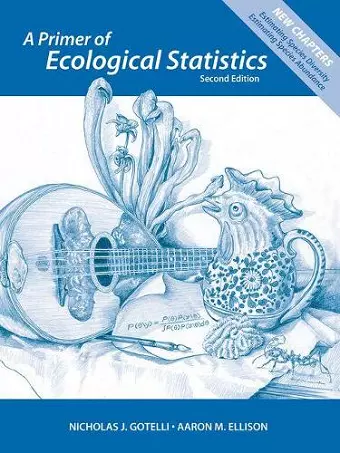A Primer of Ecological Statistics
Aaron M Ellison author Nicholas J Gotelli author
Format:Paperback
Publisher:Oxford University Press Inc
Published:14th Mar '13
Currently unavailable, and unfortunately no date known when it will be back

A Primer of Ecological Statistics, Second Edition explains fundamental material in probability theory, experimental design, and parameter estimation for ecologists and environmental scientists. The book emphasizes a general introduction to probability theory and provides a detailed discussion of specific designs and analyses that are typically encountered in ecology and environmental science. Appropriate for use as either a stand-alone or supplementary text for upper-division undergraduate or graduate courses in ecological and environmental statistics, ecology, environmental science, environmental studies, or experimental design, the Primer also serves as a resource for environmental professionals who need to use and interpret statistics daily but have little or no formal training in the subject.
The book is divided into four parts. Part I discusses the fundamentals of probability and statistical thinking. It introduces the logic and language of probability (Chapter 1), explains common statistical distributions used in ecology (Chapter 2) and important measures of central tendency and spread (Chapter 3), explains P-values, hypothesis testing, and statistical errors (Chapter 4), and introduces frequentist, Bayesian, and Monte Carlo methods of analysis (Chapter 5).
Part II discusses how to successfully design and execute field experiments and sampling studies. Topics include design strategies (Chapter 6), a 'bestiary' of experimental designs (Chapter 7), and transformations and data management (Chapter 8).
Part III discusses specific analyses, and covers the material that is the main core of most statistics texts. Topics include regression (Chapter 9), analysis of variance (Chapter 10), categorical data analysis (Chapter 11), and multivariate analysis (Chapter 12).
Part IV—new to this edition—discusses two central topics in estimating important ecological metrics. Topics include quantification of biological diversity (Chapter 13) and estimating occupancy, detection probability, and population sizes from marked and unmarked populations (Chapter 14).
The book includes a comprehensive glossary, a mathematical appendix on matrix algebra, and extensively annotated tables and figures. Footnotes introduce advanced and ancillary material: some are purely historical, others cover mathematical/statistical proofs or details, and still others address current topics in the ecological literature.
Data files and code used for some of the examples, as well as errata, are available online.
Things that set this volume apart from the ordinary include short discussions of more advanced methods at the end of most chapters, a full chapter on data management, two chapters on study design, and wonderful footnotes with historical notes and short biographies. * Philip Dixon, The Quarterly Review of Biology *
Many ecology-related degrees require only a single statistics course, leaving a wide gap between students' knowledge and what they need to know. Gotelli and Ellison's book * written by ecologists with extensive experience teaching graduate and undergraduate statistics courseshelps fill this gap. I have found this book, aided by the very easy writing style of the authors, is equally well received by graduate and undergraduate students as a textbook in courses on ecological analyses, particularly when used as a bridge to more advanced books on specific topics. The book uses ecological data throughout, much of it collected by the authors, and all data are available on the book's web site, making it easy to use those data in labs.Michael Gillingham, The American Statistician *
ISBN: 9781605350646
Dimensions: unknown
Weight: unknown
614 pages
2nd ed. 2013